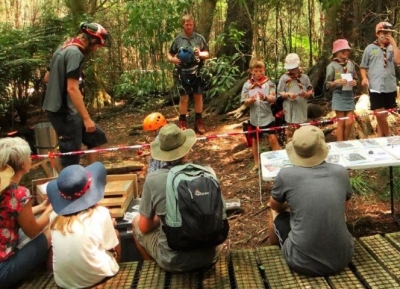World Wetlands Day events
The 2020 Puweto Festival honoured the day at Lake Rotopiko, which DU visited during its 2018 conference in Hamilton. Wetland bird masks, a critter colour-in, mudfish scrabble, eels and ladders, live geckos, kahikatea tree climbing and a virtual reality lake dive were among the offerings for families who attended.
The event was named after the shy puweto/spotless crake that lives around the margins of the lake.
Rotopiko is being developed into a National Wetland Centre, with newly completed boardwalks, information panels and an interactive discovery trail. During the festival, Treelands (local arborists) climbed up kahikatea to install bat roost boxes – something they have been doing all over the region. Other activities around the country included a guided walk at Harbourview-Orangihina Park in Te Atatu on 1 February and Matuku Reserve Trust in West Auckland had an open day to show off its wetland restoration and give the public a chance to see pateke.
In Wellington, Zealandia visitors were able to talk to experts from organisations including the Hakuturi Roopu, Greater Wellington Regional Council and Lakes380 to learn more about freshwater and wetlands in New Zealand.
In Marlborough, visitors were invited to check out a community-led wetland restoration project and walk around the Grovetown Lagoon. A guided walk was held around the Travis wetland in Christchurch.
The QEII National Trust took the opportunity on World Wetlands Day to introduce a new QEII wetland covenant to protect the Galloway Wetlands in Ashburton.
The trust said: “Craig and Lyn Galloway bought their farm in 1986 on the south bank of the North Branch of the Ashburton River. When they purchased the property, all paddocks had been developed except for the wetland paddock which remained uncultivated.
“Craig and Lyn applied to the Ashburton Water Zone committee for a grant to expand their successful riparian planting programme to the margin of a stream and man-made pond.
“Spring-fed channel wetlands like theirs have virtually disappeared elsewhere on the Canterbury Plains. They decided to place a covenant over the whole
6-hectare wetland complex to preserve the relict pre-human vegetation.
“The covenant is a rare example of the highly diverse wetland complex and landform created by hydrologically connected springs associated with braided rivers. The wetland ecotone contains a spring-fed mossy fen, bog rush channel wetland, stream, manmade ponds, pukio and kiokio fern swamp, and toetoe marsh.
“The Galloway Wetlands protect the only known manuka, sphagnum moss and the pink-flowered wetland ladies tresses orchid (Spiranthes novae-zelandiae) on the Ashburton Plains.” Matagouri and the rhizomatous shrubby violet known as a porcupine shrub have survived on the stony ridges in the covenant but both are rarely encountered elsewhere in the region, the QEII Trust said.
The landowners plan to supplement these species with new plants, grown from seed sourced from the local area. This covenant is one of very few
that meet all four national priorities for protecting rare and threatened biodiversity on private land.
But it was not all good news for wetlands. In a statement released to mark World Wetlands Day, Forest and Bird said West Coast landowners had wiped out more wetlands in the past 20 years than landowners in any other region. Aerial images from around the country supplied by Landcare Research showed that wetlands on private land were still disappearing at an alarming rate.
The West Coast was the largest wetland region in New Zealand, with nearly 84,000 hectares of freshwater wetlands, 14 per cent of them in private ownership, Forest and Bird said.
Image Gallery
https://ducks.org.nz/flight-magazine/item/367-world-wetlands-day-events#sigProIddbce690e5a


